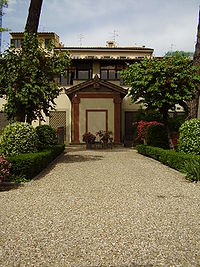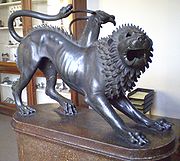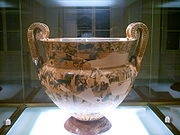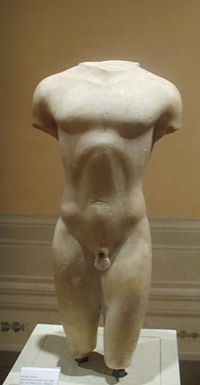
National Archaeological Museum (Florence)
Encyclopedia

Florence
Florence is the capital city of the Italian region of Tuscany and of the province of Florence. It is the most populous city in Tuscany, with approximately 370,000 inhabitants, expanding to over 1.5 million in the metropolitan area....
, Italy. It is located at 1 piazza Santissima Annunziata, in the Palazzo della Crocetta (a palace built in 1620 for princess Maria Maddalena de' Medici
Maria Maddalena de' Medici
Maria Maddalena de' Medici was an Tuscan princess, the eighth daughter of Ferdinando I and Christina of Lorraine, making her the sister of Cosimo II.-Life:...
, daughter of Ferdinand I de Medici
Ferdinando I de' Medici, Grand Duke of Tuscany
Ferdinando I de' Medici, Grand Duke of Tuscany was Grand Duke of Tuscany from 1587 to 1609, having succeeded his older brother Francesco I.-Biography:...
, by Giulio Parigi
Giulio Parigi
Giulio Parigi was an Italian architect and designer. He was the main member of a family of architects and designers working for the Grand Ducal court of the Medici...
).
History
The museum was inaugurated in the presence of king Victor Emmanuel IIVictor Emmanuel II of Italy
Victor Emanuel II was king of Sardinia from 1849 and, on 17 March 1861, he assumed the title King of Italy to become the first king of a united Italy since the 6th century, a title he held until his death in 1878...
in 1870 in the buildings of the Cenacolo di Fuligno on via Faenza. At that time it only comprised Etruscan and Roman remains. As the collections grew, a new site soon became necessary and in 1880 the museum was transferred to its present building.
The collection's first foundations were the family collections of the Medici and Lorraine, with several transfers from the Uffizi
Uffizi
The Uffizi Gallery , is a museum in Florence, Italy. It is one of the oldest and most famous art museums of the Western world.-History:...
up to 1890 (except the collections of marble sculpture which the Uffizi already possessed). The Egyptian section was first formed in the first half of the 18th century from part of the collections of Pierre Léopold de Toscane, from another part of an expedition promoted by the same Grand Duke in 1828-29 and led by Ippolito Rosellini
Ippolito Rosellini
Ippolito Rosellini was an Italian Egyptologist.-Early life:He was born at Pisa. After graduating in theology, he studied under Mezzofanti at Bologna, and in 1824 became professor of oriental languages at Pisa University.-Association with Jean-François Champollion:He was the first disciple, a...
and Champollion (the man who first deciphered hieroglyphics). In 1887 a new topographic museum on the Etruscans was added, but it was destroyed in the 1966 floods.
Etruscan collections

- The Chimera of ArezzoChimera of ArezzoThe bronze "Chimera of Arezzo" is one of the best known examples of the art of the Etruscans. It was found in Arezzo, an ancient Etruscan and Roman city in Tuscany, in 1553 and was quickly claimed for the collection of the Medici Grand Duke of Tuscany Cosimo I, who placed it publicly in the...
– discovered in 1553 at Arezzo during the construction of a Medici fortress - The statue of the Arringatore (1st century BC)
- The funerary statue Mater MatutaMater MatutaMater Matuta was an indigenous Roman goddess, whom the Romans eventually made equivalent to the dawn goddess Aurora, and the Greek goddess Eos. Mater Matuta had a temple on the Forum Boarium, and she was also associated with the sea harbors and ports, where there were other temples to her.Her...
(460-450 BC) (returned to Chianciano TermeChianciano TermeChianciano Terme is a comune in the Province of Siena in the Italian region Tuscany, located about 90 km southeast of Florence and about 50 km southeast of Siena...
) - The sarcophagus of Laerthia Seianti (2nd century BC)
- The sarcophagus of the Amazons (4th century BC)
Roman collections
- The "idolino of PesaroPesaroPesaro is a town and comune in the Italian region of the Marche, capital of the Pesaro e Urbino province, on the Adriatic. According to the 2007 census, its population was 92,206....
", a 146 cm high bronze statue of a young man, a Roman copy from a classical Greek original, found in fragments in the centre of Pesaro in October 1530. - The "torso di Livorno", copy of a 5th century BC Greek original.
- Statue of a cockerel, the so called "Gallo Treboniano", late 3rd century work.
- The Minerva of Arezzo, a bronze Roman copy of a 4th century BC Greek model attributed to Praxiteles.
Greek collections


.jpg)
The most important of the vases is a large black figure krater
Krater
A krater was a large vase used to mix wine and water in Ancient Greece.-Form and function:...
of c. 570 BC signed by the potter Ergotimos and the painter Kleitias. It is named the "François vase
François Vase
The François Vase, a milestone in the development of Greek pottery, is a large volute krater decorated in the black-figure style which stands at 66cm in height. Dated at circa 570/560 BCE it was found in 1844 in an Etruscan tomb in the necropolis of Fonte Rotella near Chiusi and named after its...
" after the archaeologist who found it in 1844 in an Etruscan tomb at fonte Rotella, on the Chiusi road, and shows a series of Greek mythological narratives on both sides. Other notable objects are
- the red figure hydriaHydriaA hydria is a type of Greek pottery used for carrying water. The hydria has three handles. Two horizontal handles on either side of the body of the pot were used for lifting and carrying the pot. The third handle, a vertical one, located in the center of the other two handles, was used when...
signed by the Meidias painter (550-540 BC) - the cups by the Little Masters (560-540 BC), named after their miniaturist style of their figures
- the sculptures of Apollo and Apollino Milani (6th century BC, named after the man who gave them to the museum)
- the athlete's torso (5th century BC)
- the large Hellenistic horse's head (known as the Medici Riccardi head after the first place it was displayed, in the Medici's Riccardi palace), fragment of an equestrian statue, which inspired DonatelloDonatelloDonato di Niccolò di Betto Bardi , also known as Donatello, was an early Renaissance Italian artist and sculptor from Florence...
and Verrocchio in two famous equestrian monuments in PaduaPaduaPadua is a city and comune in the Veneto, northern Italy. It is the capital of the province of Padua and the economic and communications hub of the area. Padua's population is 212,500 . The city is sometimes included, with Venice and Treviso, in the Padua-Treviso-Venice Metropolitan Area, having...
and VeniceVeniceVenice is a city in northern Italy which is renowned for the beauty of its setting, its architecture and its artworks. It is the capital of the Veneto region...
. - two ArchaicArchaic period in GreeceThe Archaic period in Greece was a period of ancient Greek history that followed the Greek Dark Ages. This period saw the rise of the polis and the founding of colonies, as well as the first inklings of classical philosophy, theatre in the form of tragedies performed during Dionysia, and written...
marble kouroiKourosA kouros is the modern term given to those representations of male youths which first appear in the Archaic period in Greece. The term kouros, meaning youth, was first proposed for what were previously thought to be depictions of Apollo by V. I...
, displayed in a corridor
Egyptian Museum
The Egyptian section of the collection is known as the Egyptian Museum, and is the second largest collection of Egyptian artifacts in Italy, after that of the Museo EgizioMuseo Egizio
The Museo Egizio is a museum in Turin, Italy, specialising in Egyptian archaeology and anthropology. It houses the world's largest and most comprehensive collection of Egyptian antiquities outside the Egyptian Museum in Cairo...
in Turin
Turin
Turin is a city and major business and cultural centre in northern Italy, capital of the Piedmont region, located mainly on the left bank of the Po River and surrounded by the Alpine arch. The population of the city proper is 909,193 while the population of the urban area is estimated by Eurostat...
.
Foundation
Florence's first collection of Egyptian antiquities was in the Medici collection, dating from the eighteenth century. In the nineteenth century, Leopold II, Grand Duke of TuscanyLeopold II, Grand Duke of Tuscany
Leopold II of Tuscany was the last reigning grand duke of Tuscany ....
, began acquisition of the artifacts now housed at the Egyptian Museum. Together with Charles X of France
Charles X of France
Charles X was known for most of his life as the Comte d'Artois before he reigned as King of France and of Navarre from 16 September 1824 until 2 August 1830. A younger brother to Kings Louis XVI and Louis XVIII, he supported the latter in exile and eventually succeeded him...
, he financed a scientific expedition to Egypt in 1828 to 1829. The expedition was directed by Jean-François Champollion
Jean-François Champollion
Jean-François Champollion was a French classical scholar, philologist and orientalist, decipherer of the Egyptian hieroglyphs....
, who deciphered the hieroglyphic
Egyptian hieroglyphs
Egyptian hieroglyphs were a formal writing system used by the ancient Egyptians that combined logographic and alphabetic elements. Egyptians used cursive hieroglyphs for religious literature on papyrus and wood...
script. Ippolito Rosellini, friend and student of Champollion, represented the Italian interests during the expedition. He went on to become the father of Italian Egyptology
Egyptology
Egyptology is the study of ancient Egyptian history, language, literature, religion, and art from the 5th millennium BC until the end of its native religious practices in the AD 4th century. A practitioner of the discipline is an “Egyptologist”...
. Many artifacts were collected during the expedition, both from archeological diggings, and via purchases from local merchants. On their return, these were distributed evenly between the Louvre
Louvre
The Musée du Louvre – in English, the Louvre Museum or simply the Louvre – is one of the world's largest museums, the most visited art museum in the world and a historic monument. A central landmark of Paris, it is located on the Right Bank of the Seine in the 1st arrondissement...
in Paris, and the new Egyptian Museum in Florence.
Development
The museum was officially opened in 1855. The first director was Ernesto Schiaparelli, from PiedmontPiedmont
Piedmont is one of the 20 regions of Italy. It has an area of 25,402 square kilometres and a population of about 4.4 million. The capital of Piedmont is Turin. The main local language is Piedmontese. Occitan is also spoken by a minority in the Occitan Valleys situated in the Provinces of...
. He later went on to become director of the larger Egyptian museum in Turin.
By 1880 he had catalogued the collection and organized transportation of the antiquities to the Florentine Archaeological Museum. Under Schiaparelli, the collection expanded with further excavations and purchases carried out in Egypt. Many of the artifacts were, however, later transferred to Turin
Turin
Turin is a city and major business and cultural centre in northern Italy, capital of the Piedmont region, located mainly on the left bank of the Po River and surrounded by the Alpine arch. The population of the city proper is 909,193 while the population of the urban area is estimated by Eurostat...
.
The Florentine collection continued to grow after this time, with donations from private individuals and scientific institutions. In particular, the Papyrological Institute of Florence provided artifacts from its expeditions to Egypt between 1934 and 1939. These now provide one of the most substantial collections of Coptic art and documents in the world.
The Egyptian Museum today
The museum now has a permanent staff including two professional Egyptologists. It houses more than 14,000 artifacts, distributed in nine galleries and two warehouses. The artifacts displayed in the galleries have been substantially restored. The old classification system devised by Schiaparelli is being replaced by a new, chronological and partly topographical system.The collection comprises material that extends from the prehistorical era right through to the Coptic Age. There are remarkable collections of stele
Stele
A stele , also stela , is a stone or wooden slab, generally taller than it is wide, erected for funerals or commemorative purposes, most usually decorated with the names and titles of the deceased or living — inscribed, carved in relief , or painted onto the slab...
, mummies
Mummy
A mummy is a body, human or animal, whose skin and organs have been preserved by either intentional or incidental exposure to chemicals, extreme coldness , very low humidity, or lack of air when bodies are submerged in bogs, so that the recovered body will not decay further if kept in cool and dry...
, ushabti
Ushabti
The ushabti was a funerary figurine used in Ancient Egypt. Ushabtis were placed in tombs among the grave goods and were intended to act as substitutes for the deceased, should he/she be called upon to do manual labor in the afterlife...
, amulets and bronze statuettes of several eras. There are statues from the reign of Amenhotep III
Amenhotep III
Amenhotep III also known as Amenhotep the Magnificent was the ninth pharaoh of the Eighteenth dynasty. According to different authors, he ruled Egypt from June 1386 to 1349 BC or June 1388 BC to December 1351 BC/1350 BC after his father Thutmose IV died...
, a chariot from the eighteenth dynasty, a pillar from the tomb of Seti I
Seti I
Menmaatre Seti I was a Pharaoh of Ancient Egypt , the son of Ramesses I and Queen Sitre, and the father of Ramesses II...
, a New Testament papyrus (𝔓2
Papyrus 2
Papyrus 2 is an early copy of the New Testament in Greek. It is a papyrus fragment of a copy of the Gospel of John dating to the sixth century. It is currently housed at the Egyptian Museum, Florence . There is a portion of Luke 7:22-26.50 in Coptic on the reverse of the fragment.The fragment...
, 𝔓65) and many other distinctive artifacts from many periods.
See also
- CartonnageCartonnageCartonnage is a type of material composing Egyptian funerary masks from the First Intermediate Period onward. It was made of layers of linen or papyrus covered with plaster. Some of the Fayum mummy portraits are also painted on panels made of cartonnage....
- List of New Testament papyri

